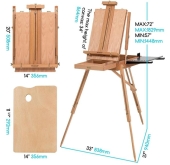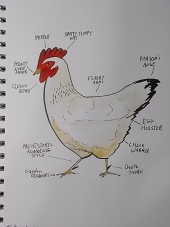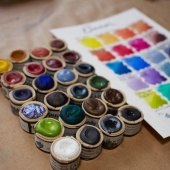
 8
8




All true wealth is biological.
Lois McMaster Bujold
 1
1




"The only thing...more expensive than education is ignorance."~Ben Franklin. "We can easily forgive a child who is afraid of the dark; the real tragedy of life is when men are afraid of the light." ~ Plato
 4
4




Carla Burke wrote:I think that's the same set as this - still pricey, but less so: https://www.dickblick.com/items/winsor-newton-artists-watercolor-field-box-set-set-of-12-assorted-colors-half-pans/







 8
8











 2
2











 7
7




 2
2











 5
5




All true wealth is biological.
Lois McMaster Bujold
 3
3











 6
6




 6
6




r ranson wrote:Is there a primer for watercolours? Like gesso? To be a glue between the paint and surface?
 5
5




 3
3




Mary Duggan wrote:Hi, nice to see a fellow beginner painter online. I quite like Beam Paints : https://www.beampaints.com/ as they are plastic-free, relatively local and colour safe. Happy creating!







 2
2




Elena Wulf wrote:I'm just wondering if you've seen any of James Gurney's videos? Here's his watercolor play list
https://www.youtube.com/playlist?list=PLRba1gHgLtJB5NpHFmnZLhXuN_kdAyLae
I'm more into pen and ink, but I love watching him. I'm not sure if he's the best thing for beginners, but he does a lot of experimenting with different techniques and materials.
You mentioned what to use when tracing your design. I know he often uses a watercolor pencil, which runs when wet and blends into the design- which might be trickier for a beginner, I wouldn't know.







 14
14




 11
11




 2
2




r ranson wrote:Is there a primer for watercolours? Like gesso? To be a glue between the paint and surface?







 5
5




The mark of a true practitioner is not what arises in your life and mind, but how you work with what arises.
Dzigar Kongtrul Rinpoche, “The Path of Patience”
 7
7




 7
7











 5
5




The mark of a true practitioner is not what arises in your life and mind, but how you work with what arises.
Dzigar Kongtrul Rinpoche, “The Path of Patience”
 5
5











 7
7











 7
7




r ranson wrote:
But the camera can't see all the things I saw. The mountains are missing because of the haze and I guess it didn't have enough colour or value difference from the sky. The boats have lost all their colour and are almost neutral tone. There's just so much information lost in the photos.
 9
9











 8
8











 2
2











 2
2




The mark of a true practitioner is not what arises in your life and mind, but how you work with what arises.
Dzigar Kongtrul Rinpoche, “The Path of Patience”
 1
1




The mark of a true practitioner is not what arises in your life and mind, but how you work with what arises.
Dzigar Kongtrul Rinpoche, “The Path of Patience”
 3
3




r ranson wrote:
1. paint flat on a table or use an easel?
2. when using a sketchbook for painting outside, how to safely close it at the end?
3. am I supposed to be doing something to re-dry my palette after painting?
4. what other questions do I need to be asking?
"Also, just as you want men to do to you, do the same way to them" (Luke 6:31)






 2
2




r ranson wrote:What about paint safety? Some of the colours are named for toxic substances. Do they use cadmium in paint making? Or is it just a name?
"Also, just as you want men to do to you, do the same way to them" (Luke 6:31)






 3
3




Mark Reed wrote:... Anyway, here is the crappy "Moon Over Water".
"Also, just as you want men to do to you, do the same way to them" (Luke 6:31)






 3
3




r ranson wrote:...New question. Why do they tape the paper edges? What are they taping it to?
"Also, just as you want men to do to you, do the same way to them" (Luke 6:31)






 3
3




r ranson wrote:Is it normal for paintbrushes to have one or two hairs 1/8th inch longer than the rest? They seem to get in the way of accuracy. Are there paintbrush police, or is it okay to cut the offending bristles?
"Also, just as you want men to do to you, do the same way to them" (Luke 6:31)






 2
2




r ranson wrote:Thanks for the link. That's a great resource.
and thank you for the help.
The bristles that stand out are a bit bent and curly so I can't convince them to put a line where I ask them to. I think I'll cut it down so it's less than 1/16th of an inch longer. 1/8th to 1/4 inch is too long for my current skillset.
That I bought the brushes in a 12-piece set tells you pretty much all you need to know about the quality. But they are hair/fir instead of nylon. Although the description kept switching between squirrel and sable so I think they were having spell-check trouble as well. They were affordable, and if I waited to save up enough to buy good quality stuff, I would never get to start.
"Also, just as you want men to do to you, do the same way to them" (Luke 6:31)






 2
2




r ranson wrote:Another question: If you could only have 3 colours, what would be your favourite?
and the same for 5 colours?
I'm looking to create a smaller pallet so I can travel with it easier and learn colour mixing.
"Also, just as you want men to do to you, do the same way to them" (Luke 6:31)






 2
2




r ranson wrote:Another question
So I paint a shape with water, then dab in wet colour. The tutorials say the colour is supposed to spread around and some of the colours in this set do. but a lot of them don't. Most of them just stay where I put them and I have to flood the paper with an excess of water (make a big dome and risk the water running away from my shape). Even then, I have to push the colour around as it won't spread out like on the tutorials I watch.
(edit to add: I tried different water colour paper - the one I know for sure is 110lb/230gsm)
I'm pretty sure I'm not supposed to need this much water.
Is it me or the paint?
"Also, just as you want men to do to you, do the same way to them" (Luke 6:31)






 2
2




r ranson wrote:Here's the latest - and yes, this is probably what I get for buying amazonbasics - but at under a dollar a tube of paint... well, got to start somewhere.
I opened the paint a few weeks ago, put some in my pans on my pallet. Now I'm ready to refill some and I get the tubes, open them up, and the paint has separated. The binder falls out of the tube, but the paint is icky.
I tried re-mixing the binder into the paint, but now the result is shiny paint which isn't what I want from watercolour.
blotting out the binder juice and the result is hard to re-wet and doesn't flow in the water like it used to.
What's the solution?
if the only solution is to buy better paint, maybe check this out first
"Also, just as you want men to do to you, do the same way to them" (Luke 6:31)






 2
2




r ranson wrote:can one watercolour paint on not-paper?
"Also, just as you want men to do to you, do the same way to them" (Luke 6:31)






 4
4




"Also, just as you want men to do to you, do the same way to them" (Luke 6:31)

|
Looky! I'm being abducted by space aliens! Me and this tiny ad!
The new gardening playing cards kickstarter is now live!
https://www.kickstarter.com/projects/paulwheaton/garden-cards
|








